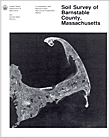The following is a map unit description from the "Soil Survey of Barnstable County, Massachusetts (Fletcher, 1993)"

MeB-Merrimac sandy loam, 3 to 8 percent slopes. This very deep, gently sloping, well drained soil is mainly in broad areas and on low hills on outwash plains but is also in areas of glacial lake deposits. It makes up about 1.7 percent (4,424 acres) of the survey area. It is mapped mainly in the Enfield-MerrimacCarver general soil map unit. Areas are irregular in shape and range from 5 to 200 acres in size.
Typically, the surface is covered with an organic layer of loose, undecomposed pine needles, leaves, and twigs about 3 inches thick. The surface layer is very friable sandy loam about 3 inches thick. The upper 1 inch is black, and the lower 2 inches is light brownish gray. The subsoil is sandy loam about 21 inches thick. The upper 4 inches is strong brown and very friable, the next 10 inches is yellowish brown and friable, and the lower 7 inches is brownish yellow and friable. The substratum to a depth of 65 inches or more is light yellowish brown, loose coarse sand.
Included with this soil in mapping are small areas of Carver, Enfield, and Hinckley soils. Also included are areas where slopes are less than 3 percent or more than 8 percent. Included soils make up about 20 percent of this unit.
Permeability is moderately rapid in the subsoil of the Merrimac soil and rapid in the substratum. Available water capacity is low. Depth to the seasonal high water table is more than 6 feet.
Most areas are used as woodland. Many areas have been developed for homesites, and some areas are used as cropland.
This soil is well suited to cultivated crops. Good tilth can be easily maintained. Erosion and droughtiness during periods of low rainfall are management concerns. Irrigation is needed for maximum crop yields. Farming on the contour or across the slope, terracing, stripcropping, including grasses and legumes in the crop rotation, growing cover crops, and applying a system of conservation tillage help to control runoff and erosion. Mixing crop residue and manure into the surface layer improves tilth and increases the available water capacity.
This soil is well suited to hay and pasture. The main management concern is the prevention of overgrazing, which reduces the hardiness and density of desirable plants. Proper stocking rates, timely grazing, and restricted use during wet periods help to maintain plant density and minimize surface compaction.
This soil is suited to woodland. Because of droughtiness, some seedling loss is expected. Removal or control of competing vegetation helps to obtain the best growth of newly established seedlings. The most common trees are pitch pine, white oak, scarlet oak, eastern white pine, and black oak.
This soil is suitable as a site for buildings with or without basements. It readily absorbs but may not adequately filter the effluent in septic tank absorption fields. The poor filtering capacity may result in the pollution of ground water. The hazard of pollution increases with the density of housing. Precautionary measures may be necessary in some areas.